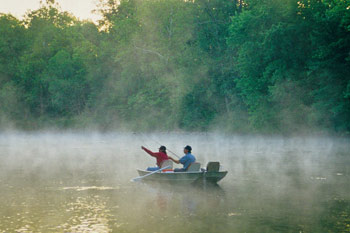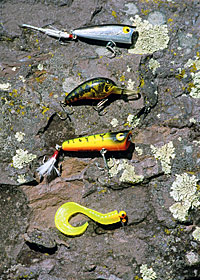
Fishing gets a lot easier if you know exactly where the fish are going to be. That’s precisely the case in the summer when water levels drop dramatically on streams and rivers home to smallmouth bass. The smaller the body of water, the more concentrated the bass become.
Earlier in the year, when rivers are roaring from spring rains and runoff, smallmouths are very structure-oriented. They have to be. Boulders, trees, bridges, stumps, and ledges block surging current flows. Bass are not found of strong, strength-sapping current and use the structure to wait out the deluge in calmer water. As water levels drop to extreme levels in the summer, the current isn’t something the bass must contend with. They often seek out current then because it provides more oxygen and prey. Deeper pools off-limits in the spring become prime holding spots in summer through early fall. Schools of bass then concentrate in the deeper pools created by outside bends in rivers. The deeper pools are even better if they have boulders, laydowns, shelves, and ledges to provide additional bass cover.
During periods of low water, smallies are free to roam wherever they like. With current being a non-factor, bass will leave the security of the deeper pools to hunt in the shallows during low light conditions. The bass patrol rock fields to root out crayfish, darters, and sculpins. Bass know that weeds contain many prey options and will hunt along the edges of the weeds in the skinny water.
Because nowhere is off-limits for smallmouth during summer months, bass can be found just about anywhere, and anglers need to cover water. Topwater baits, like buzzbaits, poppers, and prop baits, excel because you can cover water with them, they call bass from a distance, and few methods are more exciting than to see a smallie rocket up from the depths or create a wake in the shallows to blast a surface lure. Lures like the Rebel’s Pop-R, Yo-Zuri’s new 3DS Popper, Storm’s Chug Bug, Heddon’s Baby Torpedo, and Yo-Zuri’s new 3DR Prop can be fished aggressively and cover the maximum amount of water. Although it pays to experiment, the best retrieve is usually a stop-and-go cadence.
While casting angles are essential when rivers are high to get just the proper presentation and angle of drift, casting angles are unimportant when the same river flows at its lowest levels in the summer. Just try to cover as much water as possible.

A couple of decades ago, I joined Grant Schliewe and Leon Chase for a summer float down the Muskegon River. The Muskegon is one of Michigan’s premier steelhead and salmon rivers during the spring and fall and is a top-rated tail-water stream for trout below Croton Dam. Below the town of Newaygo and the closer you get to Lake Michigan, the river turns into a smallmouth nirvana with plenty of trees, boulders, and a sandier bottom than above Newaygo.
Steam rose from the warm river into the cool morning air when we launched. Trout were actively rising in the cooler morning flows. Grant manned the oars on the Jon boat, and Leon and I cast from our perches on the bow and stern. Grant instructed us to cast at a 90-degree angle to the bank and let the shiner-colored Rebel Deep Wee R swing in an arch across the current. Smallies jumped on the crankbait with regularity, and the action only got hotter as the day heated up.
Crankbaits can be an excellent choice for summer smallies because they imitate a wide range of bass forage, and you can cover a lot of water with them. Crankbaits can imitate minnows, crayfish, and even grasshoppers.
Plastics are a go-to lure for smallies in rivers because they are incredibly versatile, can be fished in various ways, and do a great job of imitating an assortment of prey that lives on the bottom of the river. Tube jigs have life-like tentacles and prominent eyes, are relatively snag-less and can be hopped, dragged, or skittered.
Twister-tailed jigs are equally effective. A 1/8- to ¼-ounce jig can be skipped and crawled along the bottom to imitate crayfish or fished on a slow, steady retrieve to imitate a baitfish. Because a twister-tailed jig is so versatile and imitates a variety of prey, many colors will fool summer smallies. Dark colors are perfect for mimicking crawfish and gobies, while brighter colors duplicate minnows. You can head to the river with a handful of jigs and a dozen twister tails, catch a ton of bass, and not lose a bunch of expensive lures.
A fast action, medium to medium-light power, 7-foot spinning rod, like Favorite Tackle’s Jack Hammer Spinning Combo (https://favoriteusa.com/jack-hammer-spinning-rod.html) is the perfect set up for river smallies. The Jack Hammer Spinning Rod has the new Fuji Titanium single stick guides making it lighter and stronger, with more sensitivity, castability, accuracy, and balance. The outfit is ideal for feeling jig as it hops over rocks and boulders along the bottom and makes long casts with crankbaits and topwater lures.
If you have the luxury of bringing two rods, have one filled with 6- to 10-pound mono and the other filled with fluorocarbon line. Monofilament floats, so it’s a better option when fishing topwater baits. Fluorocarbon sinks, so it excels at fishing jigs and crankbaits. I’m not a big fan of braid for fishing low, clear rivers in the summer.
How you attack summer smallies depends on the body of water. If you target small rivers and streams, walking the banks and wading wet might be the best option. Low, summertime waters are easy to read. Holding lies will be self-evident. Resist making your first cast the ultimate cast. Don’t risk getting snagged right off the bat and sending every bass scurrying for cover. Get at least a couple of casts in the water before you go for broke.
On larger- and medium-sized rivers, a canoe or kayak is ideal for drifting from spot to spot and getting out the fishing more thoroughly. Jon boats and jet sleds excel on huge bodies of water that have plenty of depth to float larger craft. Larger rivers also produce larger bass, but it’s all relative.
Either way, floating down a lazy river and catching feisty smallmouths with your toes dangling in the cool waters is a delightful way to spend a summer day.




